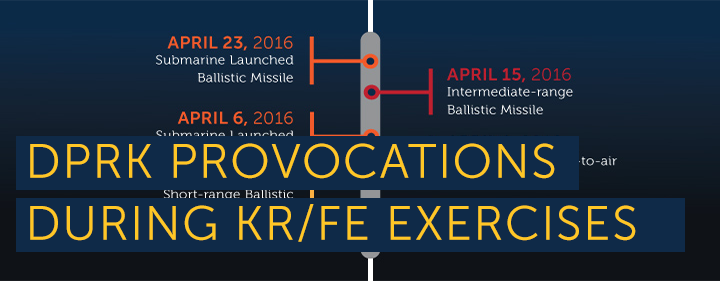
Media outlets covering the Korean peninsula routinely report each spring: “tensions set to rise on Korean peninsula as annual war games near,” or “the annual U.S.–South Korea military drill that freaks out North Korea is happening right now.” This is often mirrored by Korea Central News Agency (KCNA) pronouncements from Pyongyang that state: “The United States will be responsible for outbreak of war in Korean peninsula,” or “Key Resolve and Foal Eagle 16 will only precipitate U.S. final ruin.”
These reports, common in the media and in North Korean propaganda statements, suggest that the annual U.S.–South Korean military exercises have a provocative effect on Pyongyang’s behavior. To critically test this proposition, Beyond Parallel gathered and compared data on the relationship between the United States-Republic of Korea (ROK) military exercises and North Korean provocations. The scope of our qualitative study was the past 12 years of annual U.S.-ROK spring military exercises (2005–2016).
The Primary Findings are:
- Null effect: U.S.-ROK military exercises do not provoke North Korean belligerence, but rather have a “null effect” on the status of relations. If relations were coded positively prior to the exercises, they remained positive during and after the exercises despite the fiery rhetoric from the North. If pre-exercise relations were coded negatively, then behavior by the North during and after the exercises was negative. Therefore, annual military exercises are not game changers in U.S.–North Korea relations.
- Split personality: North Korea can compartmentalize its reactions to the U.S.-ROK military exercises. In 2005 and 2006, it insulated positive inter-Korean relations from its belligerence toward the United States during the exercise period.
- Length matters: As the duration of U.S.-ROK military exercises grew longer—beginning in 2009 when the training operations became multiweek—the window of opportunity for North Korean kinetic responses has also widened. After 2009, small-scale North Korean provocations during and after the exercise period became more common, punctuated by an unusually large number of provocations in the spring seasons of 2014 to 2016. Since Kim Jong-un assumed power in 2012, provocations during the exercise period have grown in intensity.
- Listen carefully: North Korean official rhetorical statements usually do not signal a long-range missile test or nuclear test, but they are useful indicators for smaller-scale provocations that could take place during the exercise period. North Korea’s unusually large volume of strong statements against the exercises in 2009, 2010, and 2013–2015 coincided with small-scale provocations.

METHODOLOGY OF STUDY:
We coded North Korean behavior by examining two factors:
- The status of bilateral relationships with the United States and South Korea before and after exercises (coded as positive or negative—measured by the number of positive and negative exchanges in that time period);
- North Korean rhetoric: in the form of official statements and news media.
Data was collected on the U.S.-ROK military RSOI/Foal Eagle exercises from the period 2005–2007, and Key Resolve from 2007 to present (RSOI being the military acronym for reception, staging, onward movement, and integration).
It is worth noting that this study did not include the summer exercises (Ulchi Freedom Guardian [UFG], formerly known as Ulchi Focus-Lens [UFL]) because Foal Eagle remains the primary annual field training exercise involving massive U.S. and ROK troop movements, therefore making it more likely to be seen as provocative and perceived as a “rehearsal for invasion” by North Korea (UFG/UFL, like Key Resolve, are computerized command-and-control exercises). The coded data on military exercises was then compared with information previously collected on North Korean provocations to determine whether there was a correlation between these events.
Explore the Relationship Further:
Why Is This Relevant to Korean Unification?
Small-scale kinetic military conflicts and provocations that escalate quickly into a larger conflict could draw countries into a major war. The more we understand the relationship between North Korean provocations and U.S.-ROK military exercises, the more accurately we can determine the redlines for military action and regional conflict escalation. A comparative study also helps decision makers to understand the differences between North Korean rhetoric, strategic provocations, and deliberate counter responses. This helps to avoid misunderstanding, further identify redlines, and to deter actions that would lead to major conflict.


